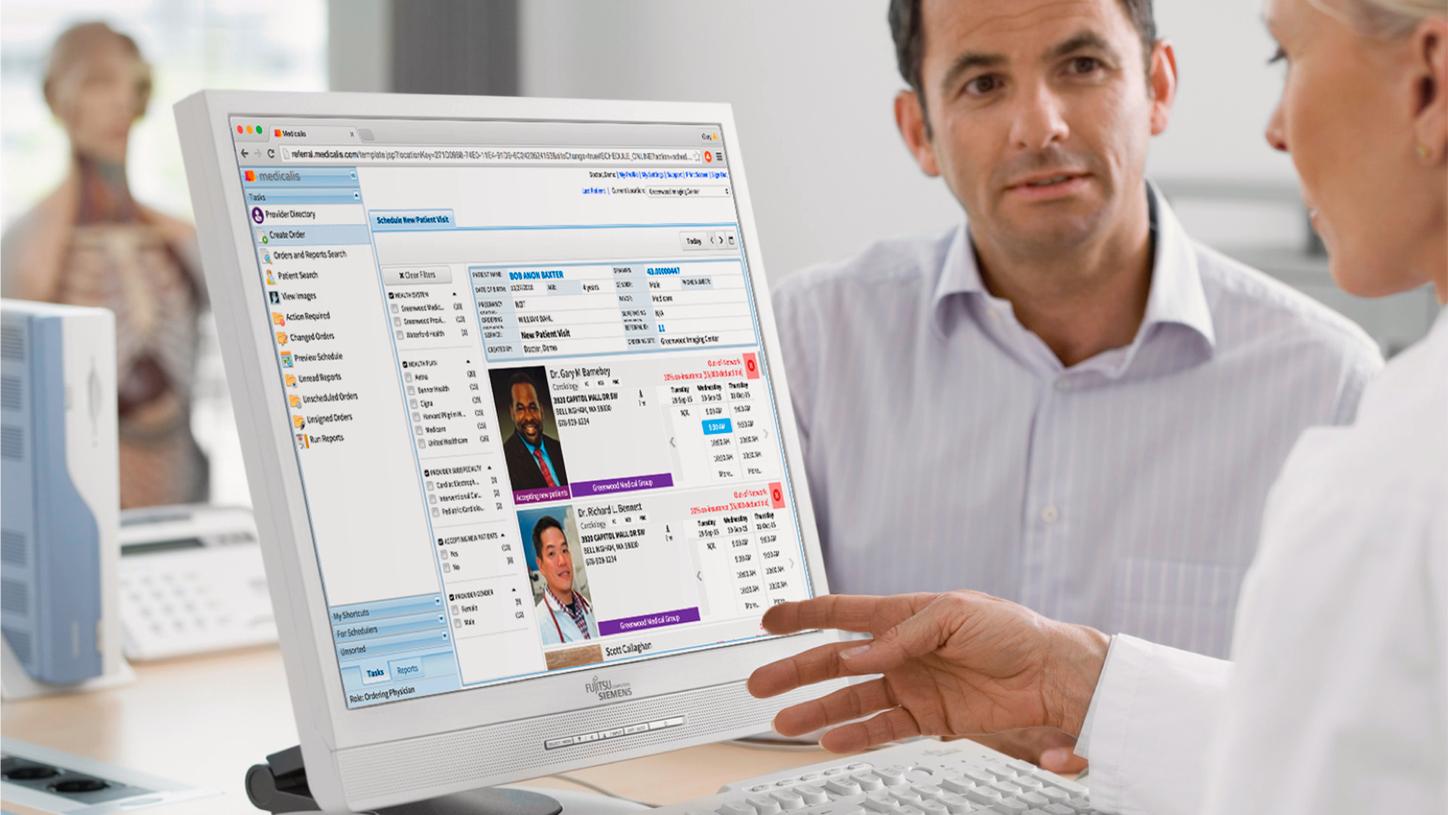- Домашня
- Медична візуалізація
- Цифрова трансформація радіології
- Artificial Intelligence in Radiology

Artificial Intelligence in RadiologyEmpowering clinical decisions with AI
Artificial intelligence (AI) has become an integral part of our daily lives. In Healthcare, AI is establishing itself into the clinical routine; the benefits of AI in radiology are immense.
AI-powered imaging
Key AI trends like informed decision making, integrated diagnostics, and digital twins*, focus very much on how radiology plays a major role in the digital transformation of healthcare and how radiologists and clinicians can be empowered to make the right decision for every patient. AI holds a vast amount of potential to transform aspects of the healthcare industry, and is not something to fear, rather it is something to embrace.
Find out how AI in radiology can enable you to respond to the growing demands for your diagnostic imaging services, address potential staff shortages, and enhance your overall imaging workflow.
How do neural networks work in medical imaging?
Neural networks do not work differently in medical imaging than in any other discipline. They just have specific tasks to fulfill that are quite different. That is also the first thing to think about: What task should the algorithm solve and what network structure will be most efficient for this task?
In this animation, you can see a plain neural network in its simplest form which can be still very complex.
Neural networks are inspired by the brain. As within the brain, they consist of multiple layers. The input layer receives the data (such as a CT volume), while hidden layers extract characteristic data features, which are relevant for the specific diagnostic task and vary between various medical fields of application. In a next step, the detection and expression of the features is being learned by the network to assess them and assign respective interpretation. To train this neural network, a large amount of data is needed to learn, for example, how to differentiate a lung nodule from a healthy lung. For the accuracy of the algorithm, it is important to have a good quality of the data to feed the algorithm, so for supervised learning for example, annotated data is needed.
To ensure the high quality of our algorithms, we collaborate with well-known institutions around the world to understand customer needs to train our algorithms accordingly.
How is AI shaping Radiology?
Artificial intelligence holds significant promise for radiology and is already starting to revolutionize healthcare in many ways. From bridging the gap between the demands of ever-increasing, extremely complex data and the number of radiologists, to simplifying data interpretation through sophisticated AI algorithms and thereby improving the diagnostic process. AI is a valuable tool that, when combined with the human expertise of radiologists and clinicians, offers vast potential to the healthcare industry.

Leveraging AI to overcome the challenges of radiology
AI can reduce the workload of radiologists by doing monotonous tasks in less time, freeing up clinicians to focus on more complex cases that require human interpretation. Through digital transformation, we can help overcome data silos and use algorithms to analyze complex and ever-increasing healthcare data. One example is the AI-Rad Companion3, a family of AI-powered workflow solutions that helps to reduce the burden of repetitive, routine tasks.

Steadily increasing workload of radiologists
One of the most pressing concerns in radiology today is the exponential growth of data from increase in radiology examinations and the shortage of medical staff to handle it. In many countries, the number of radiology examinations is skyrocketing, while the number of radiologists and imaging specialists is not keeping up with the trend. The result is a dramatically increased workload for radiologists.1

Less interpretation time means the potential for higher error rates
Higher error rates caused by shortened turnaround time
Due to the increased workload on radiologists, we risk increased error in data interpretation, as recent studies show that cutting radiologists’ interpretation time in half increases the interpretation error rate by 16.6%.2
Ultimately, this can have critical consequences.
This is where AI steps in to make a difference in improving the diagnostic process.

Leveraging AI to overcome the challenges of radiology
AI can reduce the workload of radiologists by doing monotonous tasks in less time, freeing up clinicians to focus on more complex cases that require human interpretation. Through digital transformation, we can help overcome data silos and use algorithms to analyze complex and ever-increasing healthcare data. One example is the AI-Rad Companion3, a family of AI-powered workflow solutions that helps to reduce the burden of repetitive, routine tasks.

Steadily increasing workload of radiologists
One of the most pressing concerns in radiology today is the exponential growth of data from increase in radiology examinations and the shortage of medical staff to handle it. In many countries, the number of radiology examinations is skyrocketing, while the number of radiologists and imaging specialists is not keeping up with the trend. The result is a dramatically increased workload for radiologists.1

Less interpretation time means the potential for higher error rates
Higher error rates caused by shortened turnaround time
Due to the increased workload on radiologists, we risk increased error in data interpretation, as recent studies show that cutting radiologists’ interpretation time in half increases the interpretation error rate by 16.6%.2
Ultimately, this can have critical consequences.
This is where AI steps in to make a difference in improving the diagnostic process.

Leveraging AI to overcome the challenges of radiology
AI can reduce the workload of radiologists by doing monotonous tasks in less time, freeing up clinicians to focus on more complex cases that require human interpretation. Through digital transformation, we can help overcome data silos and use algorithms to analyze complex and ever-increasing healthcare data. One example is the AI-Rad Companion3, a family of AI-powered workflow solutions that helps to reduce the burden of repetitive, routine tasks.



How can AI revolutionize clinical workflows?
In medicine, AI is
sometimes perceived as a new medical device. It isn't. AI is an enabling
technology that allows medical care to be redesigned and improved throughout
the care continuum, from prevention to aftercare.

How do we leverage AI to revolutionize radiology?
Siemens Healthineers CEO Dr. Bernd Montag explains it through a “step-by-step” approach. The first step is to begin with building more and more digitalization into our devices and incorporating AI. As the systems become more intelligent and adapt to patients, they deliver the right quality automatically. The next step is to support diagnostic findings, for example, data from a CT or MR. This is then followed by solving an even bigger challenge, which is to bring all the data from various sources together and build a digital assistant for holistic decision-making in healthcare. It is not a sudden transformation, rather a work-in constant progress.

myExam Companion is available for SOMATOM® X.cite and the entire SOMATOM go. platform, MAGNETOM Free.Max as well as for our radiography systems YSIO X.pree5 and the MULTIX Impact family6
AI is already used in the workflow, image acquisition and reconstruction space. With the help of AI, we are able to get more accurate data, important for later diagnosis. A great example for this is myExam Companion with features like the 3D camera. With an AI-based algorithm, it analyzes the patient shape and identifies key anatomic landmarks for patient pose, body region, and iso-center detection. Such AI-powered systems not only have the potential to reduce errors due to operator dependency, standardize the acquisitions in a patient specific manner, and cut down the time but can also contribute to radiation dose reduction due to automatic table-height and scan range determination. With the rapid advances of AI also in the field of diagnosis, it is very likely that AI will be used as an additional diagnosis help for examinations and reporting. This is already done today with the intelligent solution AI-Rad Companion3.
What does AI-powered workflow look like?
AI-powered applications have the potential to enhance every step of the imaging workflow and here’s how:

- Order/Schedule: AI-powered connection of patients and physicians
- Preparation and Acquisition: AI-powered standardized, accurate patient positioning and planning of exams
- Postprocessing/Quantification: AI-powered automatic lesion scoring, automatic measurements
- Interpretation/Report Generation: AI-powered automatic highlighting, characterization and quantification of anatomies and abnormalities
Discover in detail how AI solutions can empower radiologists and clinicians to make the right decision for every patient.
Order/Schedule
01Preparation/Acquisition
04Post-processing
03Interpretation
03
AI-Rad Companion Chest CT
Automated highlighting and quantification of certain anatomies and abnormalities within a Chest CT exam.4

Medicalis Referral Management and Medicalis Clinical Decision Support
Optimizes the use of resources, spread best practice, personalizes the availability and delivery of care to patients and connects patients with suitable physicians7

FAST Integrated Workflow with FAST 3D Camera
Accurate patient positioning enabled by 3D and infrared picture data input is key to safe and consistent CT imaging, reducing rescans and time loss.

BioMatrix Select&GO - intelligent body model in MRI
Accurate and standardized patient positioning enables faster and more reproducible patient set-up.

MR Dot Engines
Standardized and consistent planning for reproducible and reliable results - independent from user experience.

MR Dot Engines – AutoAlign
Automated alignment, angulation and positioning of slices saves time and reduces variability in planning procedures.

Correction of MR motion artifacts
Planned for automated detection and correction of motion artifacts, designed to be integrated within the scanning workflow – allows for less rescans.8,9

MR Dot Engine - AutoLabeling
Automated detection and labeling of the spine – makes time-consuming and repetitive procedures faster and less prone to error.

Image based input function for Multiparametric PET

MM Reading in syngo.via
Faster results with the help of extended automatic and semi-automatic segmentation tools, to add, remove or isolate anatomical structures - with less user interaction.10

Prototype functionality: Lung Ventilation and Perfusion Analysis
Deep learning based lobe segmentation assists in lung perfusion and ventilation evaluation.8

AI-Rad Companion
Powerful platform - designed for automated highlighting and quantified measuring of certain anatomies and abnormalities in a variety of dedicated exams.3

AI-Rad Companion Chest CT
Automated highlighting and quantification of certain anatomies and abnormalities within a Chest CT exam.4

Medicalis Referral Management and Medicalis Clinical Decision Support
Optimizes the use of resources, spread best practice, personalizes the availability and delivery of care to patients and connects patients with suitable physicians7

FAST Integrated Workflow with FAST 3D Camera
Accurate patient positioning enabled by 3D and infrared picture data input is key to safe and consistent CT imaging, reducing rescans and time loss.

BioMatrix Select&GO - intelligent body model in MRI
Accurate and standardized patient positioning enables faster and more reproducible patient set-up.

MR Dot Engines
Standardized and consistent planning for reproducible and reliable results - independent from user experience.

MR Dot Engines – AutoAlign
Automated alignment, angulation and positioning of slices saves time and reduces variability in planning procedures.

Correction of MR motion artifacts
Planned for automated detection and correction of motion artifacts, designed to be integrated within the scanning workflow – allows for less rescans.8,9

MR Dot Engine - AutoLabeling
Automated detection and labeling of the spine – makes time-consuming and repetitive procedures faster and less prone to error.

Image based input function for Multiparametric PET

MM Reading in syngo.via
Faster results with the help of extended automatic and semi-automatic segmentation tools, to add, remove or isolate anatomical structures - with less user interaction.10

Prototype functionality: Lung Ventilation and Perfusion Analysis
Deep learning based lobe segmentation assists in lung perfusion and ventilation evaluation.8

AI-Rad Companion
Powerful platform - designed for automated highlighting and quantified measuring of certain anatomies and abnormalities in a variety of dedicated exams.3

AI-Rad Companion Chest CT
Automated highlighting and quantification of certain anatomies and abnormalities within a Chest CT exam.4












What is the road to success for the integration of AI into clinical routine?
Healthcare is one of the most innovative fields in our society and radiology holds huge potential for new AI-powered solutions. But every innovation is only as good as its adoption into the daily routine. For healthcare, it means the new solutions need to be integrated in the clinical workflow and be financially viable. To ensure that our solutions integrate seamlessly in the clinical workflow, we work closely together with our clinical collaboration partners from the very start of new developments and with our continuous improvement and update strategy, we can react quickly on customer feedback.

German Chancellor Angela Merkel was very interested in the digital twin* of the heart at German Government’s Digital Summit
However, there are other aspects like country regulations and reimbursements that are relevant for getting these innovations into the clinical routine. Siemens Healthineers works closely with clinicians, regulators, and organizations all over the world to standardize our products to the healthcare needs, to provide the best possible outcome in the radiology workflow. At the heart of developing AI products for us lies the focus to help clinicians and radiologists with their daily work to provide better patient outcomes. While we strive to digitalize healthcare, one aspect of this transformation is Artificial Intelligence, co-developed with our customers. Because only when the developed algorithms fit the needs of our customers and follow all rules of the regulators, can we get to the adoption rate where new technology can make a difference.
Future of AI in medical imaging: Thoughts from Healthcare Experts
Artificial intelligence in clinical practice, today and tomorrow - Webcast
Dr. David Jean Winkel from the University Hospital Basel reports on the current status of the use of AI in prostate MRI, talks about the advantages of AI in automatic image acquisition and reporting and ventures an outlook on the future of AI as part of preventive patient care.
Panel: Intelligence-based decision support
How to get the full potential AI can offer into clinical practice and what other question might arise with the AI-revolution in healthcare? Jörg Aumüller (Siemens Healthineers) discusses the topic with Anthony Chang (CHOC Children’s Hospital, Orange County, USA), David Winkel (University Hospital Basel, Switzerland), Andreas Büttner (Siemens Healthineers) and Richard Frank (Siemens Healthineers) as they share their insights in this plenary session.
AI-powered decision making
Digitalization of healthcare and AI-technology can contribute significantly to decision making along the entire patient journey. Wido Menhardt (CEO of Digital Health Siemens Healthineers) explains how AI-powered decision making can help already now in your daily workflow.
Ця інформація вам допомогла?
Дякуємо
1. The Royal College of Radiologists. Clinical radiology, UK workforce census 2018 report. London: The Royal College of Radiologists, 2019.
2. Berlin L: Faster Reporting Speed and Interpretation Errors: Conjecture, Evidence, and Malpractice Implications.
3. Several devices of AI-Rad Companion are planned and under development, not commercially available in all countries, and their future availability cannot be ensured. Please contact your local Siemens Healthineers organization for further details.
4. AI-Rad Companion Chest CT is not yet commercially available in all countries and their future availability cannot be ensured.
5. YSIO X.pree is not yet commercially available in all countries. Its future availability cannot be guaranteed. Please contact your local Siemens Healthineers organization for further details.
6. MULTIX Impact VA20 and MULTIX Impact C are not commercially available in all countries. Their future availability cannot be guaranteed. Please contact your local Siemens Healthineers organization for further details.
7. The products/features (here mentioned) are not commercially available in all countries. Due to regulatory reasons their future availability cannot be guaranteed. Please contact your local Siemens Healthineers organization for further details.
8. This product/feature is based on research. It is not yet commercially available. Due to regulatory reasons its future availability cannot be guaranteed.
9. Not for clinical use
10.syngo.via can be used as a standalone device or together with a variety of syngo.via-based software options, which are medical devices in their own right.
syngo.via and the syngo.via based software options are not commercially available in all countries. Due to regulatory reasons its future availability cannot be guaranteed. Please contact your local Siemens organization for further details
*Digital twin is currently under development; is not for sale in the U.S. Its future availability cannot be guaranteed.


